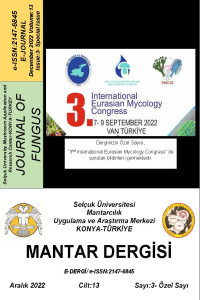Abstract
Leguminosae familyasının bir türü Cajanus cajan (L.) Millsp'dir. (Güvercin bezelyesi) otsu, yıllık, kendine tozlanan baklagil bitkisidir. Güvercin bezelyesi, besleyici kalitesi ve iyi bir mineral ve protein kaynağı nedeniyle esas olarak Güney Asya'nın birçok ülkesinde yetiştirilmektedir. Tohumlar, hastalıkların yayılması için birincil kaynak görevi gören bitki patojenlerinin ortak bir taşıyıcısıdır. Kirlenmiş tohumlar genellikle dışkılanmış çimlenme ve zayıf fide canlılığı yaratabilir. Kirlenmemiş tohumlardan çok daha hızlı canlılık kaybederler. Çok sayıda mikofloranın güvercin bezelye tohumlarıyla ilişkili olduğu bildirildi. Bazı güvercin bezelye katılımlarının tohum sağlığını ve kalitesini değerlendirmek için, bu deney İran'ın genetik departmanı ve ulusal bitki gen bankası, tohum ve bitki geliştirme enstitüsünde 2021 yılında yapılmıştır. Denemede güvercinden toplam 52 katılım yapılmıştır. laboratuvar testleri için bezelye koleksiyonları kullanıldı. Bu çalışma sırasında Alternaria spp., Aspergillus spp., Fusarium spp., Penicillium spp. ve Rhizopus spp.'nin farklı türleri. kontamine güvercin bezelyesinin filizlenen tohumları ve fideleri ile birlikte bulundu. Kontamine güvercin bezelye tohumları üzerinde en fazla tespit edilen tür %50 ile Rhizopus spp., en az ise Alternaria spp. ve %7.2 ile Aspergillus spp. Diğer türler Penicillium spp. ve Fusarium spp., kontamine tohumların sırasıyla %21.4 ve %14.2'sinde ölçülmüştür. Kirlenmiş güvercin bezelye tohumlarında, tohum çimlenmesinde %20 ila %100 azalma ölçülmüştür. Tohum sağlığına dikkat etmek, sürdürülebilir mahsul üretimi ve tohumların korunması için hastalığın entegre yönetimi için temel stratejidir.
References
- Ade-Omowaye, B. I. O., Tucker, G. A., & Smetanska, I. (2015). Nutritional potential of nine underexploited legumes in Southwest Nigeria. International Food Research Journal, 22(2), 798.
- Chaudhari, A., Sharma, H., Sharma, J. K., & Mulji, J. (2017). Seed borne fungal pathogens associated with pigeon pea seeds and their effect on seed quality parameters. Indian Journal of Plant Protection, 45(3), 293-296.
- ISTA (2022) Seed Health Testing Methods. International Rules for Seed Testing. International Seed Testing Association. Basserdorf, Switzerland.
- Jalander, V., & Gachande, B. D. (2011). Seed-Borne Mycoflora of Different Varieties of Pigeon pea (Cajanus Cajan L. Millsp.). BIOINFOLET-A Quarterly Journal of Life Sciences, 8(2), 167-168.
- Kandhare, A. S. (2014). Different seed categories of pigeon pea and its seed mycoflora. International Research Journal of Biological Sciences, 3(7), 74-75.
- Patil, D. P., Pawar, P. V., & Muley, S. M. (2012). Mycoflora associated with pigeon pea and chickpea. International Multidisciplinary Research Journal, 2(6).
Abstract
A species of Leguminosae family is Cajanus cajan (L.) Millsp. (Pigeon pea) is an herbaceous, annual, self-pollinated legume pulse crop. The pigeon pea is mainly cultivated in many countries of South Asia due to its nutritious quality and a good source of minerals and protein. Seeds are a common carrier of plant pathogens, which act as the primary source for the distribution of diseases. Contaminated seeds can often create defecated germination and poor seedling vigour. They lose viability much faster than non-contaminated seeds. A large number of mycoflora were reported to be associated with the pigeon pea seeds. To assess the seed health and quality of some pigeon pea accessions this experiment was conducted at the genetic department and national plant gene bank of Iran, seed, and plant improvement institute in 2021. In the experiment, a total of 52 accessions from the pigeon pea collection were used for laboratory tests. During this study different species of Alternaria spp., Aspergillus spp., Fusarium spp., Penicillium spp., and Rhizopus spp. were found along with germinating seed and seedlings of contaminated pigeon pea. The most identified species on the contaminated pigeon pea seeds were Rhizopus spp., with 50%, and the least were Alternaria spp. and Aspergillus spp., with 7.2%. The other species Penicillium spp., and Fusarium spp., were measured on 21.4% and 14.2% of the contaminated seeds respectively. On contaminated pigeon pea seeds, 20 to 100% reduction in seed germination has been measured. Paying attention to seed health is the fundamental strategy for the integrated management of the disease for durable crop production and seed conservation.
Supporting Institution
Seed and Plant Improvement Institute, Agricultural Research, Education and Extension Organization (AREEO)
Thanks
This work has been supported by the Seed and plant improvement Institute, Agricultural research, education and extension organization (AREEO), Karaj, Iran.
References
- Ade-Omowaye, B. I. O., Tucker, G. A., & Smetanska, I. (2015). Nutritional potential of nine underexploited legumes in Southwest Nigeria. International Food Research Journal, 22(2), 798.
- Chaudhari, A., Sharma, H., Sharma, J. K., & Mulji, J. (2017). Seed borne fungal pathogens associated with pigeon pea seeds and their effect on seed quality parameters. Indian Journal of Plant Protection, 45(3), 293-296.
- ISTA (2022) Seed Health Testing Methods. International Rules for Seed Testing. International Seed Testing Association. Basserdorf, Switzerland.
- Jalander, V., & Gachande, B. D. (2011). Seed-Borne Mycoflora of Different Varieties of Pigeon pea (Cajanus Cajan L. Millsp.). BIOINFOLET-A Quarterly Journal of Life Sciences, 8(2), 167-168.
- Kandhare, A. S. (2014). Different seed categories of pigeon pea and its seed mycoflora. International Research Journal of Biological Sciences, 3(7), 74-75.
- Patil, D. P., Pawar, P. V., & Muley, S. M. (2012). Mycoflora associated with pigeon pea and chickpea. International Multidisciplinary Research Journal, 2(6).
Details
| Primary Language | English |
|---|---|
| Journal Section | RESEARCH ARTICLE |
| Authors | |
| Publication Date | December 30, 2022 |
| Published in Issue | Year 2022 Volume: 13 Issue: 3 |
The works submitted to our journals are first judged grammatically. After this phase, articles are sent two reviewers. If necessary, the third reviewer is assessed. In the publication of works, a decision is made by evaluating the level of contribution to science and readers within the criteria specified in the writing rules. Reviewers are requested to submit their assessments within 30 days at the latest. The reviewers' evaluations and the answers to these evaluations are reviewed by the editor and it is decided whether the work will be published or not.
International Peer Reviewed Journal
The journal doesn’t have APC or any submission charges

This work is licensed under a Creative Commons Attribution 4.0 License

